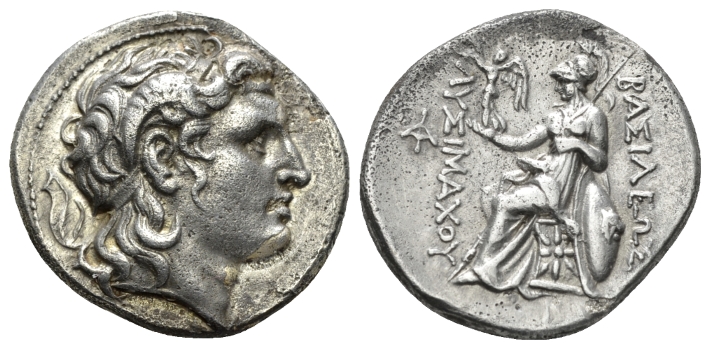Alexandria Troas (Lysimachus), silver, tetradrachms (Alexander/Athena) (304-281 BCE)
From SILVER
304 BCE - 281 BCE Silver 5,362 kg
Description
| ObverseInscription or printing placed on the obverse.: | Diademed head of deified Alexander r. with the horn of Ammon |
| ReverseInscription or printing placed on the reverse.: | BAΣΙΛΕΩΣ ΛΥΣΙΜΑΧΟΥ (Greek).Athena seated l. on throne, holding Nike and spear and resting l. elbow on shield, in outer l. field, monogram, on throne, star |
Mint and issuing power
| MintIdentifies the place of manufacture or issue of a numismatic object.: | Alexandria Troas | Ancient regionAncient region.: | Troas | Modern countryModern country: Turkey | AuthorityIdentifies the issuing power. The authority can be "pretended" when the name or the portrait of X is on the coin but he/she was not the issuing power. It can also be "uncertain" when there is no mention of X on the coin but he/she was the issuing power according to the historical sources: | Lysimachus (Macedonian officer, diadochus and king, c. 360-281 BC) |
Chronology
| FromIdentifies the initial date in a range assigned in a numismatic context. | 304 BCE | toIdentifies the final date in a range assigned in a numismatic context.. | 281 BCE | PeriodTime period of the numismatic object.: Hellenistic 323-30 BC |
Physical description
| MetalThe physical material (usually metal) from which an object is made.: | Silver |
Median weightMedian of the weights of numismatic objects (in grams). in grams | 16.85 | DenominationTerm indicating the value of a numismatic object. Examples: tetradrachm, chalkous, denarius.: | tetradrachm |
StandardStandard.: | Attic |
References
| Die study referencePublication of the study: | Meadows 20041Meadows 2004 | ||
| Coin series referenceReference to coin series study: | |||
Obverse dies distribution
| FrequencyFrequency of specimen in distribution. ᵖ | Number of obversesNumber of obverse dies. ᵖ (o) | % (o) | Number of coinsNumber of coins. (n) | % (n) | Die nameName(s) of the die(s). |
| 1 | 3 | 20 | 3 | 3 | |
| 2 | 2 | 13.33 | 4 | 4 | |
| 3 | 1 | 6.67 | 3 | 3 | |
| 6 | 2 | 13.33 | 12 | 12 | |
| 7 | 2 | 13.33 | 14 | 14 | |
| 8 | 2 | 13.33 | 16 | 16 | |
| 13 | 1 | 6.67 | 13 | 13 | |
| 16 | 1 | 6.67 | 16 | 16 | |
| 19 | 1 | 6.67 | 19 | 19 | |
| Total | 15 of 15 | 100 | 100 of 100 | 100 |
Reverse dies distribution
no distribution is available
Quantification
| Number of obversesNumber of obverse dies. ᵖ (o) | 15 | Number of singletons (o1)The number of singleton coins. ᵖ | 3 |
| Number of reverse diesNumber of reverse dies. (r) | 49 | Number of coinsNumber of coins. (n) | 100 |
| Coins per obverse dieNumber of coins per obverse die. (n/o) | 6.67 | Coins per reverse dieNumber of coins per reverse die. (n/r) | 2.04 |
| Reverse per obverse ratioRatio of obverse dies divided by reverse dies. (r/o) | 3.27 | Percentage of singletons (o1)number of coins (n) divided by the number of singletons (o1) ᵖ | 20 % |
| Original number of dies (O) (Carter 1983 formula)The estimation of the number of coins according to Carter 1983 ᵖ | 15.91 | Coins struck if 20,000 as average productivity per dieCoins made if the average productivity for obverses (according to Carter) is 20,000. ᵖ | 318,200 |
| Original number of dies (O) (Esty 2011 formula)The estimation of the number of coins according to the singleton formula in Esty 2011 ᵖ (O) | 17.65 | Survival rate if 20,000 as average productivity per dieSurvival rate if average productivity is 20,000. ᵖ | 0.00031 |
| Coverage (o = % of O) (Esty 1984 formula)Esty 1984 - coverage (% of O) ᵖ (o = % of O) | 97% | Die productivity if survival rate 1/2,000Average productivity if survival rate is 1/2,000. ᵖ | 12,570.71 |
| Weight of silver (in kg) if 20,000 coins per die (O = Carter formula)Carter 1983 * Median weight * 20000 (*10 if gold or electrum) ᵖ | 5,362 kg <br /> 5,362 kg | Die productivity if survival rate 1/5,000Average productivity if survival rate is 1/5,000. ᵖ | 31,426.78 |
Remarks
Most likely one single workstation Likely military
